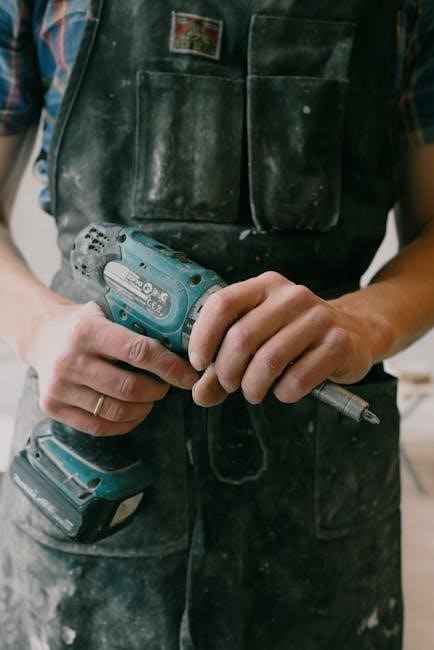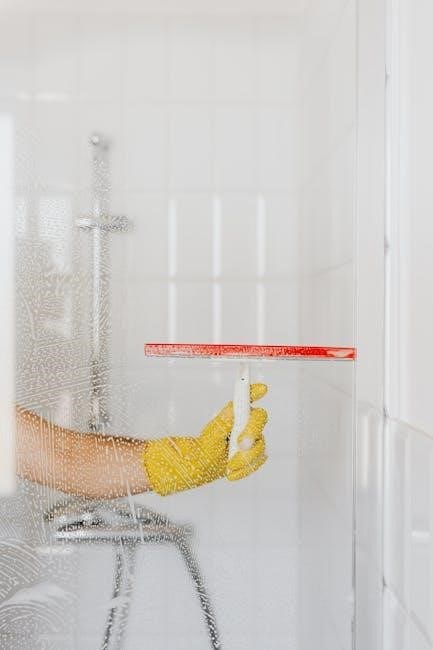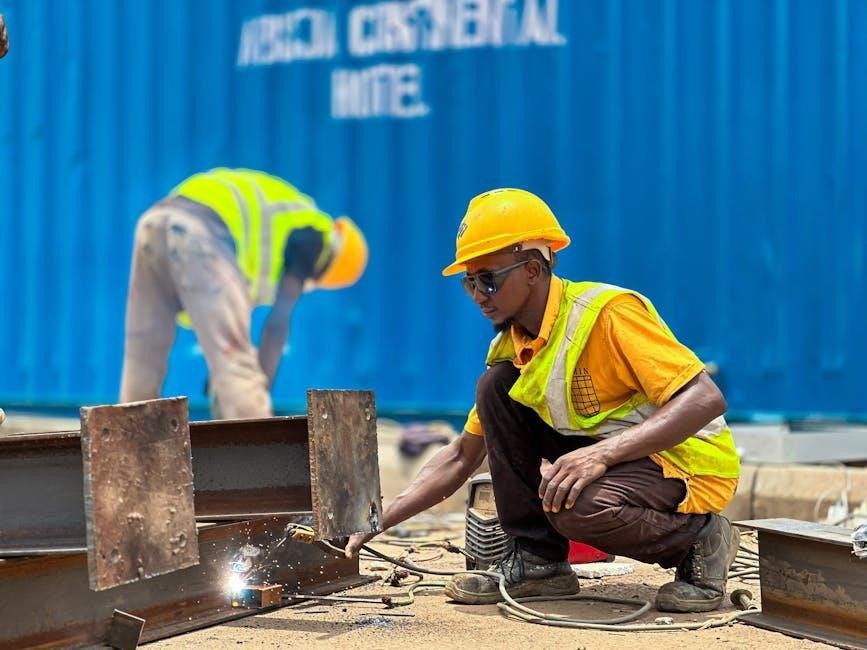This manual provides comprehensive guidance for the Kidde 900-CUAR Smoke and Carbon Monoxide Alarm, ensuring safe installation, operation, and troubleshooting for optimal home safety and performance.
1.1 Overview of the Kidde 900-CUAR Smoke and Carbon Monoxide Alarm
The Kidde 900-CUAR is a combination smoke and carbon monoxide alarm designed for home safety. It features photoelectric detection, hardwire interconnect capability with battery backup, and voice alerts. The alarm prioritizes smoke detection over CO when both hazards are present, ensuring quick response. Its self-testing feature and Hush™ function enhance reliability and user convenience.
1.2 Importance of Reading the Manual for Safe Installation and Use
Reading the Kidde 900-CUAR manual is crucial for proper installation, operation, and troubleshooting. It ensures compliance with safety standards, prevents incorrect setups, and familiarizes users with features like self-testing and voice alerts. Adhering to guidelines helps maximize the alarm’s performance and maintain home safety, avoiding potential hazards from improper use or installation.

Key Features of the Kidde 900-CUAR
The Kidde 900-CUAR combines photoelectric smoke and carbon monoxide detection, offering hardwire interconnect capability with battery backup, Hush™ feature for nuisance alarms, and self-testing with voice alerts for enhanced safety and convenience.
2.1 Combination Photoelectric Smoke and Carbon Monoxide Detection
The Kidde 900-CUAR features dual detection technology, combining photoelectric smoke sensing with carbon monoxide detection. This ensures comprehensive protection against both fire hazards and invisible CO threats in a single, user-friendly device, providing peace of mind for homeowners with accurate and reliable alerts for enhanced safety.
2.2 Hardwire Interconnect Capability with Battery Backup
The Kidde 900-CUAR supports hardwire interconnectivity, allowing multiple units to link for whole-home protection. It includes a battery backup, ensuring continuous operation during power outages. This feature enhances safety by maintaining alarm functionality and interconnectivity, even when the main power supply is interrupted, providing reliable protection at all times.
2.3 HushTM Feature for Nuisance Alarms
The HushTM feature allows temporary silencing of nuisance alarms caused by cooking smoke or steam. This convenience prevents unnecessary disruptions while maintaining safety. The alarm remains functional, ensuring it will sound in case of actual threats, providing a balance between false alarm reduction and reliable protection for your home environment.
2.4 Self-Testing and Voice Alert Capabilities
The Kidde 900-CUAR features self-testing technology that continuously monitors its functionality, ensuring reliability. The voice alert capability provides clear, audible notifications distinguishing between smoke and carbon monoxide threats, enhancing user awareness and response during emergencies for improved home safety and peace of mind.

Installation Instructions
Ensure to turn off power before starting. Follow the manual’s step-by-step guide for hardwire interconnect setup. Mount the alarm correctly and test it after installation.
3.1 Pre-Installation Requirements and Safety Guidelines
Before installation, ensure the power is off. Read the manual thoroughly. Choose locations avoiding recessed mounting. Ensure compliance with local fire codes. Use 120V AC power with AA batteries for backup. Follow all safety precautions to avoid damage or improper function. Proper setup ensures reliable detection and alarm performance for home safety.
3.2 Step-by-Step Hardwire Interconnect Installation Process
Turn off power at the circuit breaker. Connect the wires carefully, ensuring correct polarity. Mount the alarm securely, following placement guidelines. Install backup batteries. Restore power and test the alarm functionality. Interconnect with other compatible Kidde alarms for whole-home protection. Refer to the manual for detailed wiring and activation instructions to ensure proper setup and operation.
3.3 Mounting the Alarm and Ensuring Proper Placement
Mount the Kidde 900-CUAR on a ceiling or wall, at least 12 inches from the wall. Avoid recessed mounting, as it hinders smoke detection. Place alarms outside sleeping areas and at least 3 feet from cooking appliances to minimize false alarms. Ensure proper spacing and compliance with safety guidelines for optimal performance and reliability.
Maintenance and Troubleshooting
Regular maintenance ensures optimal performance. Clean the alarm monthly, test it weekly, and replace batteries annually. Troubleshoot issues like chirping by checking power sources and connections.
4.1 Routine Cleaning and Testing of the Alarm
Regular maintenance ensures the Kidde 900-CUAR operates effectively. Clean the exterior with a vacuum or soft cloth to remove dust. Test the alarm weekly using the test button to confirm proper function. Replace batteries annually or as indicated by low-battery alerts. Ensure the grille remains unobstructed for accurate detection. Perform manual tests periodically as outlined in the manual.
4.2 Resolving Common Issues Like False Alarms or Chirping Sounds
False alarms or chirping sounds on the Kidde 900-CUAR can be resolved by checking for low batteries or battery issues. Replace batteries with fresh ones and ensure proper installation. For false alarms, clean the sensor to eliminate dust or debris. If issues persist, consult the troubleshooting section of the manual for additional guidance.
4.3 Replacing Batteries and Checking Power Sources
To maintain functionality, replace the two AA backup batteries annually or when the low-battery chirp sounds. Ensure the power source is stable and check hardwire connections for integrity. Turn off power before replacing batteries to avoid electrical issues. Always use fresh, high-quality batteries to ensure reliable performance and safety of the Kidde 900-CUAR alarm system.

Operation and Testing
Understand alarm signals, voice alerts, and test the device weekly. Use the test button to ensure smoke and CO detection are functioning correctly for home safety assurance.
5.1 Understanding the Alarm Signals and Voice Alerts
Recognize distinct alarm patterns and voice notifications. The Kidde 900-CUAR emits loud beeps and voice alerts, such as “Fire!” or “Carbon Monoxide!” for clear hazard identification. Use the test button to verify functionality and ensure voice alerts are audible, providing confidence in your home’s safety system. Proper understanding ensures timely responses during emergencies.
5.2 Conducting Manual Tests for Smoke and CO Detection
Press and hold the test button to activate the alarm. The Kidde 900-CUAR will emit a loud beep, confirming functionality. Test both smoke and CO detection by exposing the sensor to smoke or using a CO test source. Regular manual testing ensures reliability and verifies that voice alerts and detection capabilities are operating correctly for your safety.

Safety Guidelines and Precautions
Avoid recessed mounting, as it impairs smoke detection. Ensure proper installation and placement to maximize effectiveness. Always comply with local fire safety codes and regulations for optimal protection.
6.1 Avoiding Recessed Mounting and Other Installation Mistakes
Recessed mounting is not recommended for the Kidde 900-CUAR, as it can hinder smoke detection and reduce alarm effectiveness. Install alarms on ceilings or walls according to manual instructions and avoid areas near vents or drafting windows to ensure accurate detection and reliable performance for maximum home safety and compliance with fire codes.
6.2 Ensuring Compliance with Local Fire Safety Regulations
Ensure the Kidde 900-CUAR installation meets local fire codes and regulations. Verify requirements for alarm placement, types, and interconnected systems. Hardwired interconnect capability with battery backup enhances compliance. Check if local codes mandate combination smoke and CO detection. Consult local fire safety authorities to confirm all installations adhere to regional standards for optimal safety and legal compliance.

Technical Specifications
The Kidde 900-CUAR operates on 120V AC hardwire with two AA battery backups. Dimensions and weight ensure compatibility with standard installations, meeting safety regulations and system requirements.
7.1 Power Requirements and Battery Information
The Kidde 900-CUAR requires a 120V AC hardwire connection for primary power, with two replaceable AA batteries serving as backup during outages. The alarm includes a self-testing feature to ensure functionality, though manual testing is still recommended for safety compliance and reliability.
7.2 Dimensions, Weight, and Compatibility with Other Systems
The Kidde 900-CUAR measures approximately 5.25 inches in diameter and 1.5 inches in depth, weighing around 1.5 pounds. It is designed to integrate seamlessly with standard home safety systems, ensuring compatibility with most hardwired setups and providing reliable performance across various installations.

Benefits of Using the Kidde 900-CUAR
The Kidde 900-CUAR offers enhanced home safety through dual smoke and CO detection, cost-effective long-term reliability, and seamless integration with existing systems for comprehensive protection and peace of mind.
8.1 Enhanced Home Safety with Dual Detection Capabilities
The Kidde 900-CUAR enhances home safety by combining photoelectric smoke and carbon monoxide detection, providing early warnings for both threats. Its voice alerts and hardwired interconnect feature ensure comprehensive protection, while the self-testing function guarantees reliability. This dual capability ensures a safer environment, offering peace of mind for homeowners with its advanced detection technologies.
8.2 Cost-Effectiveness and Long-Term Reliability
The Kidde 900-CUAR offers cost-effectiveness by combining smoke and carbon monoxide detection in a single unit, reducing the need for multiple alarms. Its hardwired design with battery backup ensures reliable operation. With self-testing features and durable construction, it provides long-term reliability, making it a trusted choice for home safety over many years.

Frequently Asked Questions
This section addresses common queries about the Kidde 900-CUAR, covering installation, troubleshooting, and maintenance, providing clear answers to ensure optimal use and understanding of the alarm.
9.1 Common Queries About Installation, Maintenance, and Troubleshooting
Users often ask about installation steps, battery replacement, and resolving issues like false alarms or chirping sounds. This section provides solutions and tips to address these concerns effectively, ensuring the alarm functions properly and maintains home safety. Proper maintenance and troubleshooting are emphasized for long-term reliability and optimal performance.
9.2 User-Submitted Questions and Answers
This section shares real user-submitted questions and answers, addressing common concerns like hardwiring, battery replacement, and silencing alarms. It provides practical advice to help users understand and resolve issues quickly, ensuring their Kidde 900-CUAR operates effectively.

Disposal and Replacement Guidelines
Properly dispose of old alarms and batteries according to local regulations. Replace the alarm after 10 years or as indicated by the manufacturer. Follow all safety guidelines.
10.1 Proper Disposal of Old Alarms and Batteries
Dispose of the Kidde 900-CUAR alarm and its batteries responsibly. Recycle batteries through approved programs and check local regulations for proper disposal methods; Remove batteries before discarding the unit to prevent environmental harm. Follow all safety guidelines to ensure eco-friendly disposal and compliance with waste management laws.
10.2 Knowing When to Replace the Alarm
Replace the Kidde 900-CUAR alarm after 10 years of service or when it emits an end-of-life chirp. The self-testing feature ensures reliability, but periodic checks are essential. Replace batteries annually, and if the alarm malfunctions or shows wear, consider replacing it to maintain safety and performance standards.
This concludes the Kidde 900-CUAR manual. Adhering to the guidelines ensures optimal safety and functionality. Regular maintenance and proper usage are crucial for effective protection.
11.1 Final Thoughts on the Importance of the Kidde 900-CUAR Manual
The Kidde 900-CUAR manual is essential for ensuring safe and correct installation and operation. It provides clear instructions and safety guidelines, helping users maximize the alarm’s effectiveness in protecting their homes from fire and carbon monoxide threats. Always refer to the manual for troubleshooting and maintenance to ensure continuous reliability and peace of mind.
11.2 Encouragement to Follow the Manual for Optimal Safety
Adhering to the Kidde 900-CUAR manual ensures proper installation, operation, and maintenance, maximizing safety. By following guidelines, users can avoid potential hazards and false alarms. Regular testing and adherence to safety tips guarantee the alarm functions correctly, providing peace of mind and protecting lives from fire and carbon monoxide threats effectively.
